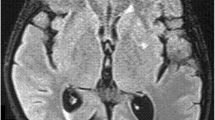Summary
Mycotic encephalitis was found in 11 out of 29,659 autopsies (7 cases of candidosis and 4 of phycomycosis).
In 10 cases the mycosis was secondary to some other severe primary disease. Primary candidosis was only found in one 17-year-old girl who had had thrush and onychomycosis from childhood.
In at least 8 cases the CNS became involved by haematogenous spread; in one case the possibility of direct infection during an intracranial operation could not be completely excluded and one was more likely to have been a primary infection during intrathecal injection for purposes of treatment. Spread per continuitatem occurred from the nasal sinuses in one case of phycomycosis.
Acute disseminated Candida encephalitis with a nonspecific tissue reaction predominated in infants. In adults the infection had mostly a chronic course as a granulomatous meningoencephalitis.
In one case, concentric layers of well and poorly staining Candida organisms alternated in the granulomata. In the layer of dying organisms “asteroid bodies” were found, in addition to numerous bizarre forms of Candida organisms.
In phycomycosis, involvement of the vessels (mycotic thromboangiitis) predominated, leading to the development of extensive ischaemic necrosis.
Zusammenfassung
Unter 29659 Autopsien fanden sich 11 Fälle von mykotischer Encephalitis (7 Candidosen und 4 Phycomykosen).
10 Fälle von ZNS-Mykose waren Sekundäraffektionen bei anderen Primärerkrankungen. Eine primäre Candidiasis fand sich lediglich bei einem 17 jährigen Mädchen, bei der seit Kindheit Soor und eine Onychomykose bestand.
In mindestens 8 Fällen erfolgte die ZNS-Infektion durch hämatogene Aussaat. Bei einem konnte die Möglichkeit einer Direktinfektion bei intrakranieller Operation nicht ausgeschlossen werden. Bei einem weiteren Fall erscheint eine Primärinfektion durch eine intrathekale Injektion zu therapeutischen Zwecken möglich. Aussaat per continuitatem von den Nebenhöhlen erfolgte bei einem Fall von Phycomycosis.
Akute disseminierte Candida-Encephalitis mit unspezifischer Gewebsreaktion überwog bei Kindern. Bei Erwachsenen zeigte die Infektion meist einen chronischen Verlauf als granulomatöse Meningoencephalitis. Bei einer Beobachtung wechselten konzentrische Schichten von gut und schlecht gefärbten Candida-Organismen in den Granulomen ab. In der Schicht absterbender Organismen fanden sich “asteroide Körperchen” neben zahlreichen bizarren Candida-Formen.
Bei Phycomykosen überwog eine Gefäßaffektion(mykotische Thromboangiitis), die zu ausgedehnten ischämischen Nekrosen führte.
Similar content being viewed by others
References
Amon, H., u.W. Schreyer: Sepsis mycotica (Candidiasis) mit disseminierter Thrombarteriitis. Frankfurt. Z. Path.71, 370–382 (1961).
Aronson, S. M., R. Benham, andA. Wolf: Maduromycosis of the central nervous system. J. Neuropath. exp. Neurol.12, 158–168 (1953).
Bader, G.: Die viszeralen Mykosen. Jena: Fischer 1965.
Bednář, B.: Posmortální diagnostika akutních encefalitid se zvláštním zřetelem k encefalitidě klíšťové. Čas. Lék. čes.94, 133–137 (1955).
Giessler, G., u.F. Gullotta: Moniliasis des Zentralnervensystems.Zbl. allg. Path. path. Anat.105, 433–439 (1964).
Hurley, R.: Experimental infection with Candida albicans in modified hosts. J. Path. Bact.92, 57–67 (1966).
Iyer, S., Ph. R. Dodge, andR. D. Adams: Two cases of Aspergillus infection of the central nervous system. J. Neurol. Neurosurg. Psychiat.15, 152–163 (1952).
John, C., J. Schindler u.M. Vorreith: Experimentální infekce kandidou albicans. In:Obrtel, J.: Onemocnění vyvolaná kvasinkovitými mikroorganismy, p. 61–69. Praha: SZdN 1956.
Kohout, J., u.V. Vlach: Meningitis zp68-1sobená Candida albicans. Neurol. psychiat. čs.18, 449–457 (1955).
Lurie, H. I.: Histopathology of sporotrichosis. Notes on the nature of the asteroid body. Arch. Path.75, 421–437 (1963).
Straatsma, B. R., L. E. Zimmermann, andJ. D. M. Gass: Phycomycosis. Lab. Invest.11, 963–985 (1962).
Symmers, W. St. C.: Deep-seated fungal infections currently seen in the histopathologic service of a medical school laboratory in Britain. Amer. J. clin. Path.46, 514–545 (1956).
Vlach, V.: Mykotická onemocnění ústřední nervové soustavy. Praha: SZdN 1958.
Vorreith, M., L. Bareš, Vl. Beneš, u.J. Vančuřík: Kandidóza centrálního nervového systému rozpoznaná bioptickým vyšetřením. Čas. Lék. čes.100, 966–971 (1961).
Winner, H. I., andR. Hurley: Candida albicans. London: Churchill1964.
Wybel, R. E.: Mycosis of cervical spinal cord following intrathecal penicillin therapy. Arch. Path.52, 167–173 (1952).
Author information
Authors and Affiliations
Rights and permissions
About this article
Cite this article
Vorreith, M. Mycotic encephalitis. Acta Neuropathol 11, 55–68 (1968). https://doi.org/10.1007/BF00692795
Received:
Issue Date:
DOI: https://doi.org/10.1007/BF00692795




